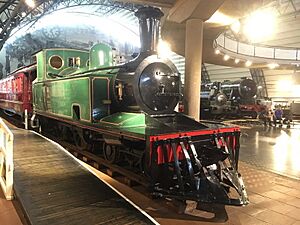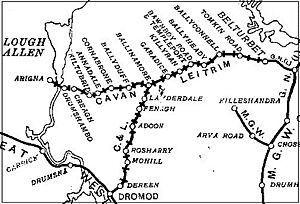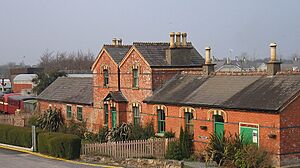Cavan and Leitrim Railway facts for kids
The Cavan and Leitrim Railway was a special kind of train line called a narrow-gauge railway. It ran in parts of County Leitrim and County Cavan in Ireland. This railway operated for many years, from 1887 until 1959.
It was quite unusual because it mainly carried coal from the mines at Arigna. Even though it was built to transport cattle, the coal traffic helped it survive longer than many other narrow-gauge lines in Ireland. Some older train engines from other lines even found a new home here!
Contents
How the Railway Started
The idea for the Cavan and Leitrim Railway had strong support from important people, like Henry King-Tenison, 8th Earl of Kingston. He lived at Kilronan Castle and wanted to help the area become more successful.
In September 1883, a meeting was held in Ballinamore. People decided that a light railway and tramway would be great for moving coal and iron from the Arigna and Lough Allen areas. A company was then set up to build and run the railway. The Earl of Kingston was the chairman of this company.
Where the Trains Went
The main railway line was about 54 kilometers (34 miles) long. It connected the towns of Dromod and Belturbet. There was also a branch line, about 24 kilometers (15 miles) long, that went from Ballinamore to Arigna.
The line from Belturbet to Dromod passed through many places. These included Tomkin Road, Ballyconnell, Bellaheady, Bawnboy Road, Killyran, Garadice, Ballinamore, Lawderdale, Fenagh, Adoon, Rosharry, Mohill and Dereen.
The branch line from Belturbet to Arigna went through Ballinamore and then continued through Ballyduff, Cornabrone, Annadale, Kiltubrid, Creagh and Drumshanbo to reach Arigna.
The Railway's Final Years
In 1925, the Cavan and Leitrim Railway joined a larger company called the Great Southern Railways. The entire railway system, including all its lines, eventually closed down in 1959.
The Trains (Locomotives)

When the railway first opened, it had eight steam locomotives. These were built by a company called Robert Stephenson and Company. Later, a ninth locomotive joined the fleet in 1904.
Over the years, some locomotives from other railway lines in Ireland were moved to the Cavan and Leitrim Railway. For example, after the Cork, Blackrock and Passage Railway closed, some of its engines came here in 1933. Later, between 1941 and 1958, four more locomotives arrived from the Tralee and Dingle Light Railway after their services ended. This meant the Cavan and Leitrim line used a variety of different train engines throughout its history.
Keeping the History Alive
Today, you can visit the Cavan & Leitrim Railway at the old Dromod Station in County Leitrim. It's a private museum that has many interesting things to see. You can find narrow-gauge trains, buses, planes, fire engines, and even old artillery guns from World War I and World War II.
Volunteers work hard to keep a short section of the railway running. They have even rebuilt some of the old steam locomotives. One locomotive, named "Nancy," was restored and started running again in 2019. Another locomotive, "Dromod," is also part of the collection.
One of the original locomotives, No. 2, and one of the original carriages are kept safe at the Ulster Folk and Transport Museum. Another locomotive, No. 3, known as 'Lady Edith,' is displayed in a museum in the United States. There are hopes to bring it back to Ireland one day. The frame of another old carriage is preserved at the Stradbally Woodland Railway.
See also
- List of heritage railways in the Republic of Ireland



